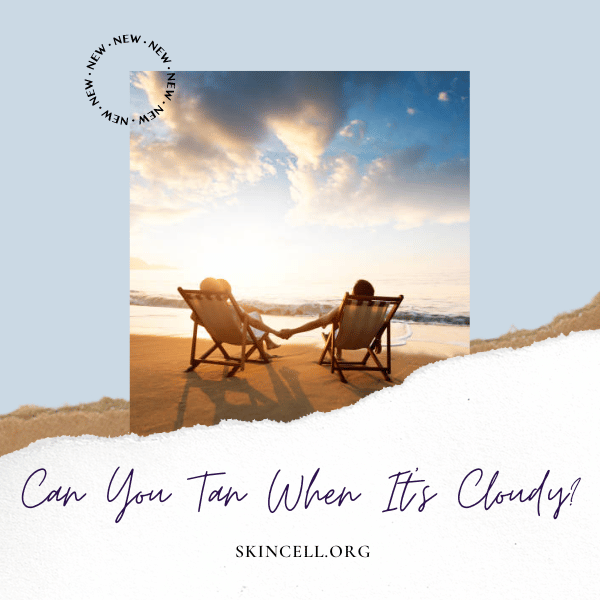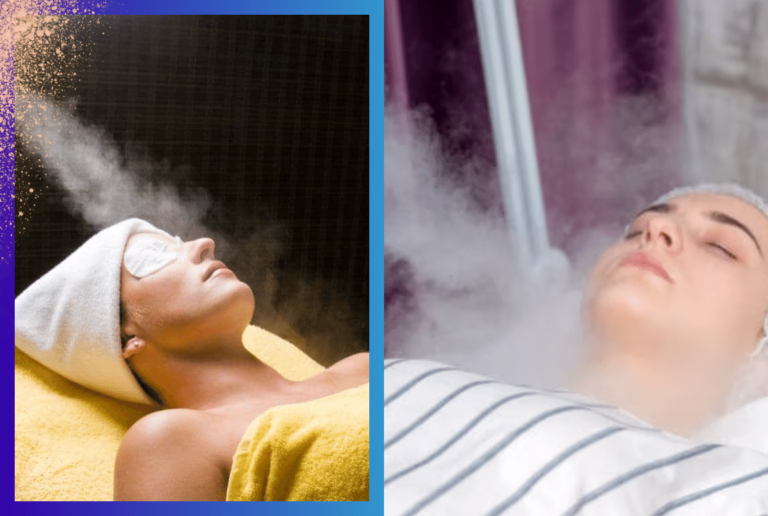Can You Tan When It’s Cloudy?
Can you really catch those tanning rays even when the sun seems to be playing hide and seek behind the clouds?
This intriguing question is one that many sun-seekers ponder, especially when faced with a less-than-clear sky on a day meant for basking in the sun. The answer lies within the intriguing interplay between cloud cover and UV radiation.
Well, we’ll be going over:
- How do different types of clouds impact the amount of UV radiation that reaches us?
- Is it possible to achieve a sun-kissed glow under the veil of clouds, and what precautions should be taken?
- How can you ensure your skin’s safety while trying to tan on a day when the sun isn’t in full view?
Let’s dive in.

Key Takeaways
- Clouds can block some of the UV radiation that causes tanning, but the amount of radiation that penetrates the clouds depends on the type of clouds, their thickness, and altitude.
- Tanning under clouds can still expose you to harmful UV radiation, leading to sunburn, premature aging, and an increased risk of skin cancer.
- To protect your skin from UV radiation, you should use effective sun protection strategies, such as wearing protective clothing, using sunscreen, and avoiding tanning during peak UV hours.
Understanding UV Radiation and Cloud Cover
The Science of UV Rays
Before we dive into the effect of clouds on UV penetration, let’s first understand what UV radiation is. Ultraviolet radiation (UV) is a type of electromagnetic radiation that is emitted by the sun. It is divided into three categories: UVA, UVB, and UVC. UVC is absorbed by the ozone layer and does not reach the earth’s surface, but UVA and UVB do. UV rays are responsible for sunburn, premature aging, and skin cancer.
Clouds and UV Penetration
Clouds can play a significant role in the amount of UV radiation that reaches the earth’s surface. The amount of UV radiation that penetrates through clouds depends on the type of cloud and its thickness.
Thick clouds can block most of the UV radiation, while thin or scattered clouds can still allow some UV radiation to pass through. The minimal cloud coverage required to significantly reduce UV radiation is around 70%.
It is important to note that clouds do not block all UV radiation. Even on a cloudy day, some UV radiation can still reach your skin. Therefore, it is still important to protect your skin by wearing sunscreen, hats, and protective clothing.
In summary, UV radiation is a type of electromagnetic radiation emitted by the sun that can cause skin damage and cancer. Clouds can block some of the UV radiation, but not all of it. Thin or scattered clouds can still allow some UV radiation to pass through. It is always important to protect your skin from UV radiation, even on cloudy days.
Health Risks of Tanning Under Clouds
Tanning under clouds may seem like a safe option to achieve that perfect tan, but it can still pose several health risks. Even on a cloudy day, the sun’s harmful UV rays can penetrate the clouds and reach your skin. In this section, we will discuss the potential health risks associated with tanning under clouds.
Potential for Sunburn
One of the most immediate risks of tanning under clouds is the potential for sunburn. While clouds can reduce the intensity of UV rays, they do not block them completely. As a result, your skin can still get burned even on a cloudy day. Sunburn can cause pain, redness, peeling, and even blistering in severe cases.
Long-Term Skin Damage
Tanning under clouds can also cause long-term damage to your skin. Prolonged exposure to UV rays can lead to premature aging, including wrinkles, age spots, and sagging skin. Additionally, UV rays can damage the DNA in your skin cells, which can increase the risk of skin cancer.
Increased Risk of Skin Cancer
Perhaps the most significant risk associated with tanning under clouds is an increased risk of skin cancer. UV rays can damage the DNA in your skin cells, which can lead to the development of cancerous cells. According to the American Cancer Society, exposure to UV radiation is a major risk factor for most skin cancers.
To protect your skin from the harmful effects of UV rays, it is essential to take precautions when tanning. Use a broad-spectrum sunscreen with an SPF of 30 or higher, wear protective clothing, and avoid tanning during peak hours when the sun’s rays are strongest. By taking these steps, you can still achieve a beautiful tan while keeping your skin healthy and safe.
Effective Sun Protection Strategies
When it comes to protecting your skin from the harmful effects of the sun, there are several strategies that you can employ. In this section, we will discuss some of the most effective sun protection strategies.
Choosing the Right Sunscreen
One of the most important steps in protecting your skin from the sun is choosing the right sunscreen. Look for a broad-spectrum sunscreen that protects against both UVA and UVB rays. The Sun Protection Factor (SPF) of the sunscreen you choose should be at least 30. A higher SPF will provide even more protection.
When applying sunscreen, be sure to follow the instructions on the label. Apply enough sunscreen to cover all exposed skin, and reapply every two hours or after swimming or sweating.
Importance of Reapplication
It is important to reapply sunscreen every two hours, even if you are not swimming or sweating. Sunscreen can wear off over time, and reapplication ensures that your skin stays protected.
Additional Protective Measures
In addition to wearing sunscreen, there are other measures you can take to protect your skin from the sun. Wearing protective clothing, such as long-sleeved shirts and hats, can help shield your skin from the sun’s harmful rays.
Seek shade when possible, especially during the peak hours of 10 a.m. to 4 p.m. And remember that even on cloudy days, you can still get sunburned, so it is important to take sun protection seriously.
By following these sun protection strategies, you can help protect your skin from the harmful effects of the sun.
Best Practices for Tanning on Cloudy Days
If you’re planning to tan on a cloudy day, it’s important to take some precautions to ensure that you do so safely. Here are some best practices to follow:
Monitoring the UV Index
Even on a cloudy day, the sun’s harmful UV rays can still penetrate your skin. It’s important to monitor the UV index to determine the strength of the sun’s rays. You can do this by checking your local weather forecast or by using a UV index app. When the UV index is high, it’s best to avoid tanning altogether.
Hydration and Skin Care
Tanning can be dehydrating for your skin, so it’s important to stay hydrated before, during, and after your tanning session. Drink plenty of water and avoid alcohol and caffeine, which can dehydrate your skin.
You should also take care of your skin by moisturizing before and after your tanning session. Use a moisturizer that is specifically designed for tanning, as this will help to keep your skin hydrated and healthy.
Timing Your Sun Exposure
When tanning on a cloudy day, it’s best to do so in the early morning or late afternoon when the sun’s rays are less intense. This will help to reduce your risk of sunburn and other skin damage.
You should also use a tanning lotion with a high SPF to protect your skin from the sun’s harmful rays. Apply the lotion liberally and reapply every two hours or after swimming or sweating.
By following these best practices, you can safely tan on a cloudy day without putting your skin at risk. Remember to stay hydrated, use a high SPF tanning lotion, and monitor the UV index to ensure that you are tanning safely.
Alternatives to Natural Sun Tanning
When it’s cloudy outside, getting a natural tan from the sun might not be possible. But fear not, there are several alternatives you can try to achieve that sun-kissed glow without exposing yourself to harmful UV rays. Here are some options:
Tanning Lotions and Oils
Tanning lotions and oils are a popular alternative to natural sun tanning. They work by stimulating the production of melanin in your skin, which gives you a darker complexion. These products come in various forms such as sprays, creams, and gels.
They also come in different strengths and shades, allowing you to choose the one that suits your skin tone and preferences.
When using tanning lotions and oils, it’s essential to follow the instructions carefully to avoid streaks and uneven patches. It’s also important to do a patch test to ensure that you’re not allergic to any of the ingredients.
Using Tanning Beds Wisely
Tanning beds are another alternative to natural sun tanning. They use UV radiation to darken your skin, just like the sun. However, tanning beds can be harmful if used excessively or incorrectly. It’s important to use them wisely and in moderation.
When using tanning beds, it’s essential to wear protective eyewear to prevent eye damage. It’s also important to follow the instructions carefully and not exceed the recommended exposure time. Overexposure to UV radiation can increase your risk of skin cancer and premature aging.
Fake Tan Options
Fake tans are a safe and effective alternative to natural sun tanning. They come in various forms such as sprays, lotions, and mousses. They work by temporarily staining the outer layer of your skin with a pigment called dihydroxyacetone (DHA).
Fake tans can give you a natural-looking tan without exposing you to harmful UV radiation. They’re also easy to apply and come in different shades to suit your preferences. However, it’s important to follow the instructions carefully to avoid streaks and uneven patches.
In conclusion, when it’s cloudy outside, you don’t have to give up on your dream of having a sun-kissed glow. There are several alternatives to natural sun tanning that you can try. Whether it’s tanning lotions and oils, tanning beds, or fake tans, you can achieve that beautiful bronzed look without exposing yourself to harmful UV rays.
Frequently Asked Questions
How long does it typically take to tan on a cloudy day?
The time it takes to tan on a cloudy day depends on several factors, such as the UV index, your skin type, and the amount of cloud cover. Generally, it takes longer to tan on a cloudy day than on a sunny day because clouds block some of the sun’s UV radiation.
It may take up to two to three times longer to tan on a cloudy day than on a sunny day.
Is the ability to tan enhanced or reduced when there are clouds?
The ability to tan is reduced when there are clouds because clouds block some of the sun’s UV radiation. UV radiation is necessary for the skin to produce melanin, which is responsible for the tanning process. Therefore, when there are clouds, less UV radiation reaches the skin, and it takes longer to tan.
Are high UV index conditions sufficient to tan even with cloud coverage?
High UV index conditions are not sufficient to tan even with cloud coverage. While a high UV index indicates that there is more UV radiation reaching the earth’s surface, clouds still block some of the UV radiation. Therefore, it may take longer to tan on a cloudy day, even with a high UV index.
Is it possible to tan through clothing on overcast days?
It is possible to tan through clothing on overcast days, but the amount of tanning is significantly reduced. Clothing blocks some of the UV radiation, and the amount of UV radiation that penetrates clothing depends on the type of fabric and the color.
Therefore, it is still advisable to wear sunscreen even on overcast days.
What level of UV index is necessary for tanning in cloudy conditions?
A UV index of 3 or higher is necessary for tanning in cloudy conditions. However, it may take longer to tan on a cloudy day than on a sunny day with the same UV index.
Does the temperature, such as 70 degrees, affect the tanning process?
The temperature does not affect the tanning process. Tanning is a result of UV radiation, and the temperature does not affect the amount of UV radiation that reaches the skin. However, it is still important to protect your skin from the sun’s harmful rays, even on cooler days.






